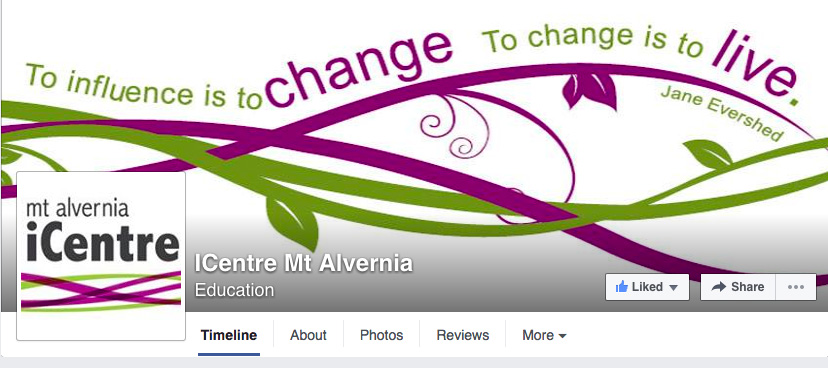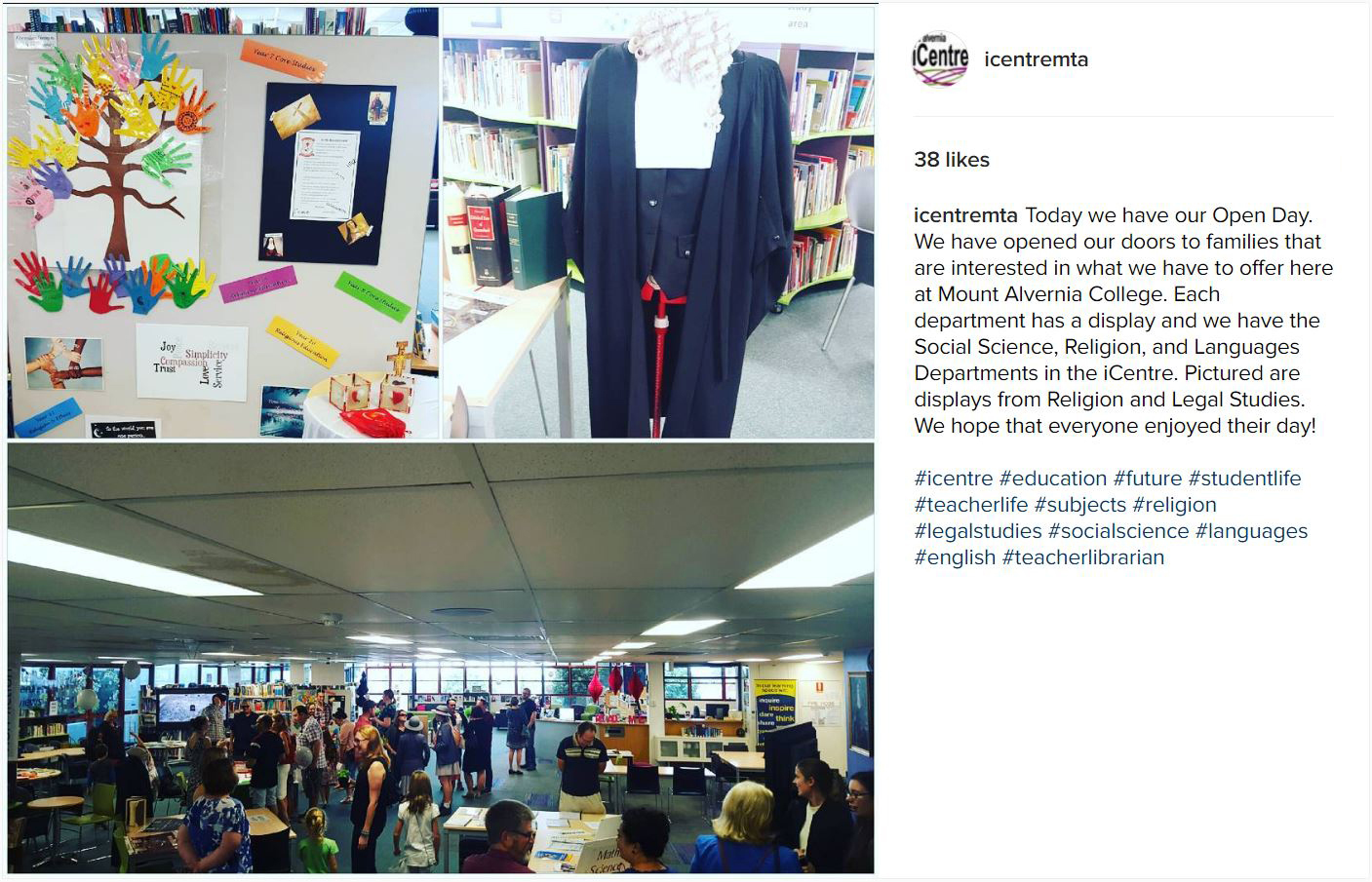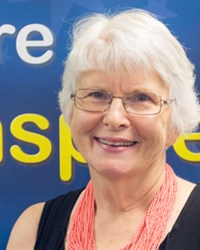Issue 98
Term 3 2016
Using social media to support school library services
Helen Stower and Margaret Donaghue, from Mt Alvernia College’s iCentre, write about their experiences using social media as a communication platform for their school’s library. They highlight the importance of libraries sharing their stories, and discuss the need to develop social media guidelines in order to minimise potential risks.
Mt Alvernia iCentre was an early adopter of social media for school library services, and is now five years into the journey which began experimentally and involved a steep learning curve. Currently, we are in the process of drafting social media guidelines and strategies. If we were to embark on using social media today, these guidelines would be our first step. This article shares our story about learning to use social media platforms as one avenue of moving our library services into the digital age.

Screenshot of iCentre Mt Alvernia's Facebook page
Learning about new information landscapes
We began investigating the use of social media in the spirit of leading pedagogical change. We wanted to embrace new technologies and the significant shifts in the global information landscape, both of which saw the rise of mobile technology, social media, and cloud computing (O’Connell 2014). Our goals for using social media began with the desire to understand these new information landscapes. In order to reach such an understanding, it was essential that we positioned ourselves as learners. We realised we had to participate in social media to understand how it worked, and how it might benefit students and teachers (Valenza 2014).
At that time, our vision was to connect our learners with the skills, tools, and information they needed to live and work in the digital age. Enabled by our principal, we adopted Facebook as our first social media channel, which we used to communicate and promote library services. After engaging in our own professional learning, Twitter was adopted and we began to coach teachers and students to use social media to build their own personal learning networks (PLNs). We went on to experiment with other platforms including curation tools such as Scoopit, Flipboard, Pearltrees, Pinterest, and Goodreads, with the last two becoming permanent choices. Our Instagram account was added in 2015 as we became aware that students had migrated to this platform, and that we needed to be there as well.
Social media guidelines are particularly necessary in the school setting where the age of students, institutional values, and parental concerns necessitate consideration.
Learning how to engage in social media
As this was new territory for everyone, conversations with college leadership about purpose, security, branding, and the ownership of intellectual property were necessary (Stower 2012, p. 14). However, the potential for educational learning in these networks was quickly realised and it was not long before the college and other areas of the school also had Facebook pages and Twitter accounts. Consequently, when we worked with web designers to build an iCentre website that revisioned our digital space, the team insisted that our Facebook and Twitter feeds be included on the home page.
Along the journey, we have discovered many things. We quickly learned that enabling, not blocking, was the key to success in using these platforms. Additionally, an essential aspect of the teacher librarian role emerged: digital citizenship needed to be modelled so that our learners were able to connect and participate safely, legally, and ethically in these new and emerging online environments. Although parents were initially concerned, we used our social media accounts to model best practice digital literacy and digital citizenship skills. The focus changed as we realised that social media was not effective for learning and teaching if the platforms were only used as push technologies without engaging users in the process. Rather, we learned that the learning potential of such platforms lies in using these tools as conduits for knowledge building, literacy, and communication.
Learning how social media supports school library services
In the early days, our lack of knowledge, experience, and understanding of how to use social media for school library services meant taking the first steps was daunting. Yet, as we persevered, we began to discover that many of our traditional functions could be accomplished, and even enhanced, by using social media. Through Facebook, Twitter, and Instagram, we are able to broadcast library content and draw attention to the collection material.
These channels also allow immediate feedback, responses, and interactions with our community. Examples of these interactions include students writing to us on Twitter to ask for book recommendations, colleagues contacting us to share professional experiences, and parents sharing Facebook posts about online safety. Twitter has also become a great platform to alert teaching staff about news, events, and resources particular to their faculties.
Another role of school libraries is to curate information for students. Traditionally, a teacher librarian may have set aside a trolley of books on a research topic or created a pathfinder for students. We have discovered that Pinterest is an excellent curation tool that enables us to point students to resources from our collection, as well as to external collections and web sources relevant to topics they are researching. We also use Pinterest as a virtual display board to promote reading and fiction. Some examples of this include our boards titled ‘Books for mighty girls’, ‘Series to follow’, and ‘Dystopian literature’.
Another gem we have uncovered is that one of the affordances of social media is the almost instant data that users can collect as feedback to inform future practice. When we share our programs, events, and tutorials on Facebook, we quickly learn if a particular post is important for parents by the number of views, likes, and shares it receives.

This then means we can be more targeted and relevant with future posts. Similarly, a tweet that resonates with colleagues will receive high numbers of retweets. We use Instagram to connect to our student body by celebrating their achievements, broadcasting their book interests and reviews, and notifying them of upcoming activities. It is heartening that our most popular posts on this platform are those that feature student work and opinion.
Finally, at the recent Edutech Conference in Brisbane, both Kate Torney, CEO of the State Library of Victoria, and Dr Ross J. Todd, Associate Professor in Library and Information Sciences at Rutgers University, stressed to delegates of the Future Libraries stream that if libraries are to thrive, then they must share their story. Social media platforms have been a powerful way for the Mt Alvernia iCentre to share its story.
The need for social media guidelines
For school libraries contemplating going down the path of using social media, there are some important considerations that need to be kept in mind. Social media guidelines are particularly necessary in the school setting where the age of students, institutional values, and parental concerns necessitate consideration.
At the Mt Alvernia iCentre, our journey has taken us in a back-to-front process; we leapt into these environments without establishing such procedures to underpin our practice. This was largely because social media was an emerging technology, and organisations were just starting to realise the potential for connecting with clients and communities. Since that time, there have been multiple examples of businesses and professionals making extraordinary mistakes on these digital platforms and discovering that actions that are not legal, ethical, or safe in online environments have real-world consequences. Simultaneously, as our use of social media platforms expanded we also experienced changes to our team in the iCentre. Consequently, we have realised that guidelines must be developed in order to both protect and showcase the college’s reputation, the iCentre’s brand, and the individual staff who are given the responsibility of using social media as part of their service delivery.
We are currently in the editing stage of creating our social media guidelines, having completed research and an initial draft. Feedback from this process will inform any changes to be made to our guidelines. In the research and drafting process, we have discovered that it is essential that our social media guidelines are in line with wider college values. It is also important that the iCentre vision and mission statements underpin the behaviours advised throughout the guidelines. Furthermore, the guidelines must be a practical document that can inform iCentre staff about appropriate actions for social media use.
At this stage, our guidelines are to:
• Know our legal responsibilities
• Understand how to stay safe
• Always act ethically
• Balance social media and work productively
• Observe professional standards.
These guidelines are structured under the following headings:
• Rationale
• Definition
• Purpose of social media use
• Audience
• Principles.

Screenshot of iCentre Mt Alvernia's Instagram account
The learning potential of [social media] platforms lies in using these tools as conduits for knowledge building, literacy, and communication.
Where to next?
Following the editing process, the guidelines will be presented to stakeholders such as the college principal and leadership team, the iCentre team, and teaching and learning staff. These guidelines will be posted in shared environments for all to access as required. Our next step will be to research and draft social media strategies that assist the team to achieve deliberate outcomes from their posts and interactions in social media.
The story of the Mt Alvernia iCentre’s journey into using social media for school library services is not complete. In fact, we hope it never will be, as the essence of our journey centres around continuous transformation. This is very much a story of trial and error, and we don’t claim that we have found a model that will work for every school library — what we do hope is that we can share our ideas, and that something we have done or experienced will help others on their journey.
References
- O’Connell, J 2012, ‘So you think they can learn?’, Scan, no. 31, pp. 5-11, viewed 26 May 2014, http://heyjude.files.wordpress.com/2006/06/joc_scan_may-2012.pdf.
- O’Connell, J 2014, ‘INF530 Concepts and practices for a digital age: Module 1.3’, lecture notes, INF530, Charles Sturt University, viewed 4 October 2014, http://digital.csu.edu.au/inf530/module-4-globalization-of-learning.
- Stower, H 2012, ‘From library to iCentre’, School Library Association of QueenslandNewsletter, no. 45, pp. 4-7.
- Valenza, J 2014, ‘Mt. Alvernia: the journey to iCentre’, School Library Journal, blog post, viewed 25 September 2014, http://blogs.slj.com/neverendingsearch/2014/06/07/mt-alvernia-the-journey-to-icentre.
Image credits
- Mt Alvernia iCentre. Used with permission

